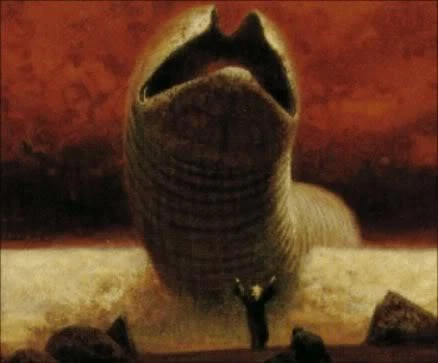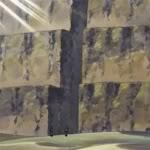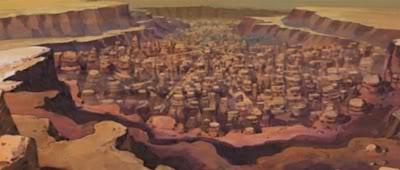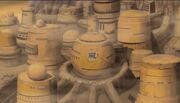
Sunagakure (砂隠れの里, Sunagakure no Sato; Literally meaning "Village Hidden in the Sand") lies in the Land of Wind. One of the five great ninja villages, Sunagakure's leader is the Kazekage. Of the four Kazekages, the most recent is Raijin Hikari. Ninja from this village are known to specialize in Fuuton, Dokuton and Kugutsu no Jutsu.
Gathered together from the various desert dwelling warriors of the sands, Sunagakure has the smallest population of all the great nations. The shinobi make up for this deficit with their ferocity. Philosophy: success of a mission supersedes all, even the lives of the warriors involved. The sands present a variety of dangers for any outsider who dares to trespass upon their world.
The Sand Seas Surrounding Sunagakure is the expanse of the desert. The Great Sand Worms, Giant Scorpions, bands of Bedouins and sand storms are common hazards. The Sand Worm is of colossal size and hunted as a source of food for the villagers. Despite being edible, they are not mild cattle but fierce predators of the sands.
Great Cliffs of Sunagakure The wall about Suna has a narrow entrance to the cul-de-sac guarded by Shinobi. Within are dungeons and tunnels to the village full of traps and mazes. In the Office of Registration, Utagai, an overly tall woman of the sands, is assisted by Shiyata, her junior officer. Despite the prevailing misconception, the walls of Suna are not as easily torn apart as one might think for they are of the living rock formations that make up the very foundations upon which the sands pass daily.
Dungeons of Sunagakure For those unhappy individuals who find themselves conscripted 'guests' of Sunagakure no Sato, the dungeons offer a wide variety of delights. There are the open population wards, where the inhabitants of this underground world commingle sharing the vast experiences with one another to the delight of all, save the weakest among them. The privileged members of this congregation, have lavished upon them spa treatment under the skilled hands of the desert's finest interrogators. Such individuals are often house in single occupancy dwellings. Those who excel even beyond the privileged few, are treated to the finest suits known as oubliettes. Here the aesthetic one can forget about life's woes and concentrate his meditations upon more esoteric concerns. This marvelous resort is accessed through the numerous tunnels beyond the guard stations with in the cliff walls themselves.
Streets of Sunagakure Upon entering the streets of Sunagakure one is immediately inundated by a wide variety of sights, sounds, color, and smells of the bazaar. This is in stark contrast to the bleak environs of the sand seas in which the village is encompassed. And perhaps this is precisely why the people of Sunagkaure had adopted such a rich and vibrant culture to counter the dreary nondescript sands.
Vibrant tarps, providing shade in front of shops, cover the wares of a variety of merchants each with their own unique style of attracting customers. Foods cooked there before the buyer's eyes send a melange of scent through the air, cries of sales and the splendors of what you can find only here create a din of music to assail the visitor's ears. Glass blowers, utilizing Suna's greatest resource...namely the sands, can be seen in competition one with the other dotted about the streets. Clothiers, and silk merchants, leather workers, and metals smiths all eke their living from the streets each day. The occasional wandering minstrel, as likely to pick your pocket as to sing you a ditty, passes by with a grin and a tug of his cap. The occasional merchant can be found selling the rare and unusual oddity, be it real or false...let the buyer be ware. The most decadent and ostentatious of venders can be found selling...le gasp...beef...to his discriminating customers.
During business hours the village seems almost choked with people, yet let nightfall and you wonder where the life in this desert abode has gone. Small wonder; nights in the desert plummet to chilling temperatures forcing most sensible people indoors to seek heat and rest. Still, life can be found at night, but it is a risky business to do so.
List of the Local Shops:
- Silver's Glass Blower Shop: Description to follow
- Chusaki's Ice Cream Parlor: Description to follow
- Asadi's Brewery: Description to follow
- Sabumaru's Teahouse: Description to follow
- Haruto's Inn: Description to follow
- Life on A String: CJ's Kugutsu Store. The title of the puppet shop is displayed above the entrance in red lettering. Above the "Life on a String" lettering are two large hands holding the traditional crossed sticks with strings used to manipulate ordinary puppets, with the strings leading down to the words. Once stepping into the puppet shop, the smell of fresh, oiled wood is all around. To the right are display cases showing unique and finely crafted puppets of the highest caliber. In the center of the shop and on the left toward the back are shelves with puppets of all sizes and uses sitting on them, ranging from small child puppets to the slightly more experienced. Just as you enter on the left are 3 or 5 combat puppets (depending on which are there and the sizes) on full display with prices attached. Near the back wall is a counter with a cash register and a open notebook on the far side for people to list puppets to be made. A small ring can be seen in the back corner, a handle to descend into a lower area. On the other side are stairs that go behind a wall into the upper floor.
- Osa's Underground Sake House The underground sake house was owned and run by a formidable woman named Osa who has quite a shrew eye for business. Built beneath the sands of Suna, the sake house stayed cool despite the oppressive heat of the desert. Schist slaps of stone had been hauled in for the roof which here supported by thick hand hewn beams of Cedar imported from some far off region. The gods knew that had been a costly endeavor but clearly Osa could afford to outfit her establishment with such luxuries. Broad steps led off the patio, outside at ground level, down to the house below from which soft music could be heard. Una, the saucy waitress whom Osa had adopted for her own, tended her customers with a quick whit and reliable service. Marzipan, the mysteriously militant chef, was famed for the ability to reproduce any dish upon request.
The Town Square resides off the center of the village and is a large round courtyard into which the streets spill rather like the spokes of a wheel. It is encompassed by stone wall upon which carvings of the villager's heroic pasts, legends of their gods, and lore of the land is depicted. Inside large niches, about the courtyard side of the wall, reside large statues hewn of stone. The statues depict noted warriors and Kazekages of the past. One in particular is of a warrior mounted upon the body of a fire lizard in which three kunai are embedded into the chest of the warrior up to their hilts. A well marks the centerpiece of the courtyard with steps of stone encircling it. Within the courtyard festivals are held on various holidays. Otherwise it is peoples with children at play, old and young couples walking about and neighbors visiting.




